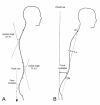Postural Adaptations of the Spinopelvic Parameters in the Sagittal Plane Induced by the Use of High-Heeled Shoes in a Sample of Young Healthy Female Subjects: A Pilot Study
- PMID: 40491621
- PMCID: PMC12146676
- DOI: 10.7759/cureus.83768
Postural Adaptations of the Spinopelvic Parameters in the Sagittal Plane Induced by the Use of High-Heeled Shoes in a Sample of Young Healthy Female Subjects: A Pilot Study
Abstract
This pilot study aimed to investigate postural adaptations in spinopelvic parameters on the sagittal plane following the use of high-heeled shoes over a prolonged period in a population of healthy young women. Thirty-four female participants were assessed using rasterstereography at three time points: standing barefoot (T1), immediately after wearing their own high-heeled shoes (T2), and after two consecutive hours of standing or walking while wearing the shoes (T3). The evaluation focused on trunk inclination, pelvic tilt, lumbar lordotic angle, and thoracic kyphotic angle. Participants were also stratified into two subgroups based on self-reported history of low back pain (LBP) during high-heel use: 13 symptomatic and 21 asymptomatic individuals. The statistical analysis, conducted using both parametric and non-parametric tests due to the borderline normality of the data, revealed no significant postural changes between T2 and T3, nor any relevant differences between the two subgroups. Only a modest variation in the kyphotic angle was observed between T1 and T3, which may not be clinically relevant. Notably, none of the participants reported pain after the two-hour protocol. These findings suggest that, in inexperienced users, high-heeled shoes do not induce significant spinopelvic compensations or acute lumbar discomfort following moderate-duration use. As this is the first study to evaluate postural outcomes after sustained use rather than immediate heel elevation, further research with larger and more diverse samples is warranted to better elucidate the potential role of heel-induced adaptations in the etiology of LBP.
Keywords: anterior pelvic tilt; high heels; low back pain; lumbar lordotic angle; postural adaptations; raster-stereography; spinopelvic profile.
Copyright © 2025, Colonna et al.
Conflict of interest statement
Human subjects: Consent for treatment and open access publication was obtained or waived by all participants in this study. IRB-Manus Sapiens issued approval 002-2023, dated October 30, 2023. Animal subjects: All authors have confirmed that this study did not involve animal subjects or tissue. Conflicts of interest: In compliance with the ICMJE uniform disclosure form, all authors declare the following: Payment/services info: All authors have declared that no financial support was received from any organization for the submitted work. Financial relationships: All authors have declared that they have no financial relationships at present or within the previous three years with any organizations that might have an interest in the submitted work. Other relationships: All authors have declared that there are no other relationships or activities that could appear to have influenced the submitted work.
Figures

References
-
- Association of low back pain with the use of high heel in ladies: a systematic review. Younas AS, Tanveer F, Sharif F, Waseem I, Mahmood W, Ahmad A. Anaesth Pain Intensive Care. 2023;27:681–688.
-
- The effect of heel height on gait and posture: a review of the literature. Cowley EE, Chevalier TL, Chockalingam N. J Am Podiatr Med Assoc. 2009;99:512–518. - PubMed
-
- High-heeled-related alterations in the static sagittal profile of the spino-pelvic structure in young women. Dai M, Li X, Zhou X, Hu Y, Luo Q, Zhou S. Eur Spine J. 2015;24:1274–1281. - PubMed
-
- High heeled shoes: their effect on center of mass position, posture, three-dimensional kinematics, rearfoot motion, and ground reaction forces. Snow RE, Williams KR. Arch Phys Med Rehabil. 1994;75:568–576. - PubMed
-
- Footwear and posture. Compensatory strategies for heel height. de Lateur BJ, Giaconi RM, Questad K, Ko M, Lehmann JF. https://pubmed.ncbi.nlm.nih.gov/1910649/ Am J Phys Med Rehabil. 1991;70:246–254. - PubMed
LinkOut - more resources
Full Text Sources
Research Materials
Miscellaneous
